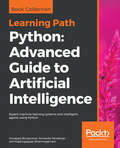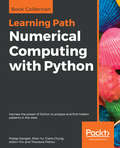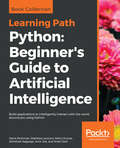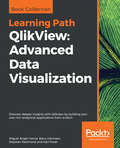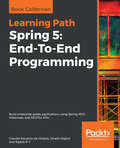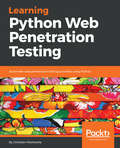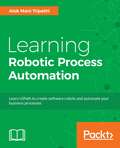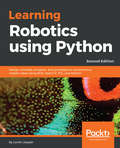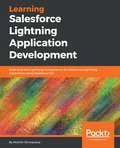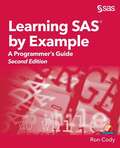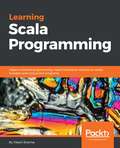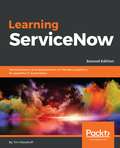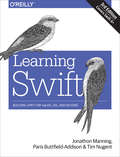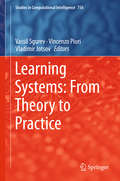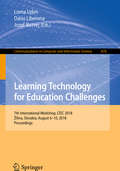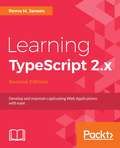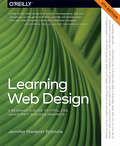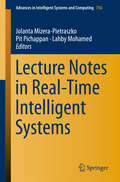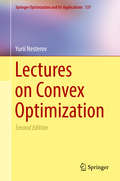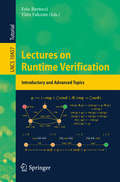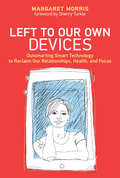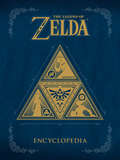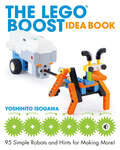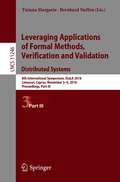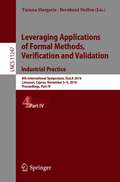- Table View
- List View
Learning Path - Python: Expert Machine Learning Systems And Intelligent Agents Using Python
by Rajalingappaa Shanmugamani Armando Fandango Giuseppe BonaccorsoThis Learning Path is for data scientists, machine learning engineers, artificial intelligence engineers who want to delve into complex machine learning algorithms, calibrate models, and improve the predictions of the trained model. You will encounter the advanced intricacies and complex use cases of deep learning and AI. A basic knowledge of programming in Python and some understanding of machine learning concepts are required to get the best out of this Learning Path.
Learning Path - Python: Harness The Power Of Python To Analyze And Find Hidden Patterns In The Data
by Theodore Petrou Aldrin Yim Claire Chung Allen Yu Pratap DangetiIf you want to learn how to use the many libraries of Python to extract impactful information from your data and present it as engaging visuals, then this is the ideal Learning Path for you. Some basic knowledge of Python is enough to get started with this Learning Path.
Learning Path - Python: Beginner's Guide to Artificial Intelligence
by Md. Rezaul Karim Giancarlo Zaccone Vahid Mirjalili Sebastian Raschka Denis RothmanThis Learning Path is for anyone who wants to understand the fundamentals of Artificial Intelligence and implement it practically by devising smart solutions. You will learn to extend your machine learning and deep learning knowledge by creating practical AI smart solutions. Prior experience with Python and statistical knowledge is essential to make the most out of this Learning Path.
Learning Path - QlikView: Advanced Data Visualization
by Karl Pover Stephen Redmond Barry Harmsen Miguel Angel GarciaThis Learning Path is designed for developers who want to go beyond their technical knowledge of QlikView and understand how to create analysis and data visualizations that solve real business needs. To grasp the concepts explained in this Learning Path, you should have a basic understanding of the common QlikView functions and some hands-on experience with the tool.
Learning Path - Spring 5: End to End Programming
by Rajesh R V Dinesh Rajput Claudio Eduardo OliveiraIf you're a developer starting out with Spring, then this learning path will help you learn about the new Spring 5.0 framework concepts followed by their implementation in Java and Kotlin. If you are an experienced Spring developer, then this Learning Path will enable you to gain insights into the new features added in Spring 5.0.
Learning Python Web Penetration Testing: Automate web penetration testing activities using Python
by Christian MartorellaLeverage the simplicity of Python and available libraries to build web security testing tools for your applicationKey FeaturesUnderstand the web application penetration testing methodology and toolkit using PythonWrite a web crawler/spider with the Scrapy libraryDetect and exploit SQL injection vulnerabilities by creating a script all by yourselfBook DescriptionWeb penetration testing is the use of tools and code to attack a website or web app in order to assess its vulnerability to external threats. While there are an increasing number of sophisticated, ready-made tools to scan systems for vulnerabilities, the use of Python allows you to write system-specific scripts, or alter and extend existing testing tools to find, exploit, and record as many security weaknesses as possible. Learning Python Web Penetration Testing will walk you through the web application penetration testing methodology, showing you how to write your own tools with Python for each activity throughout the process. The book begins by emphasizing the importance of knowing how to write your own tools with Python for web application penetration testing. You will then learn to interact with a web application using Python, understand the anatomy of an HTTP request, URL, headers and message body, and later create a script to perform a request, and interpret the response and its headers. As you make your way through the book, you will write a web crawler using Python and the Scrappy library. The book will also help you to develop a tool to perform brute force attacks in different parts of the web application. You will then discover more on detecting and exploiting SQL injection vulnerabilities. By the end of this book, you will have successfully created an HTTP proxy based on the mitmproxy tool.What you will learnInteract with a web application using the Python and Requests librariesCreate a basic web application crawler and make it recursiveDevelop a brute force tool to discover and enumerate resources such as files and directoriesExplore different authentication methods commonly used in web applicationsEnumerate table names from a database using SQL injectionUnderstand the web application penetration testing methodology and toolkitWho this book is forLearning Python Web Penetration Testing is for web developers who want to step into the world of web application security testing. Basic knowledge of Python is necessary.
Learning Robotic Process Automation: Create Software robots and automate business processes with the leading RPA tool – UiPath
by Alok Mani TripathiDesign RPA solutions to perform a wide range of transactional tasks with minimal cost and maximum ROIKey FeaturesA beginner's guide to learn Robotic Process Automation and its impact on the modern worldDesign, test, and perform enterprise automation task with UiPathCreate Automation apps and deploy them to all the computers in your department.Book DescriptionRobotic Process Automation (RPA) enables automating business processes using software robots. Software robots interpret, trigger responses, and communicate with other systems just like humans do. Robotic processes and intelligent automation tools can help businesses improve the effectiveness of services faster and at a lower cost than current methods.This book is the perfect start to your automation journey, with a special focus on one of the most popular RPA tools: UiPath.Learning Robotic Process Automation takes you on a journey from understanding the basics of RPA to advanced implementation techniques. You will become oriented in the UiPath interface and learn about its workflow. Once you are familiar with the environment, we will get hands-on with automating different applications such as Excel, SAP, Windows and web applications, screen and web scraping, working with user events, as well as understanding exceptions and debugging. By the end of the book, you'll not only be able to build your first software bot, but also you'll wire it to perform various automation tasks with the help of best practices for bot deployment.What you will learnUnderstand Robotic Process Automation technologyLearn UiPath programming techniques to deploy robot configurationsExplore various data extraction techniquesLearn about integrations with various popular applications such as SAP and MS OfficeDebug a programmed robot including logging and exception handlingMaintain code version and source controlDeploy and control Bots with UiPath OrchestratorWho this book is forIf you would like to pursue a career in Robotic Process Automation or improve the efficiency of your businesses by automating common tasks, then this book is perfect for you. Prior programming knowledge of either Visual Basic or C# will be useful.
Learning Robotics using Python: Design, simulate, program, and prototype an autonomous mobile robot using ROS, OpenCV, PCL, and Python, 2nd Edition
by Lentin JosephDesign, simulate, and program interactive robots Key Features Design, simulate, build, and program an interactive autonomous mobile robot Leverage the power of ROS, Gazebo, and Python to enhance your robotic skills A hands-on guide to creating an autonomous mobile robot with the help of ROS and PythonBook DescriptionRobot Operating System (ROS) is one of the most popular robotics software frameworks in research and industry. It has various features for implement different capabilities in a robot without implementing them from scratch.This book starts by showing you the fundamentals of ROS so you understand the basics of differential robots. Then, you'll learn about robot modeling and how to design and simulate it using ROS. Moving on, we'll design robot hardware and interfacing actuators. Then, you'll learn to configure and program depth sensors and LIDARs using ROS. Finally, you'll create a GUI for your robot using the Qt framework. By the end of this tutorial, you'll have a clear idea of how to integrate and assemble everything into a robot and how to bundle the software package.What you will learn Design a differential robot from scratch Model a differential robot using ROS and URDF Simulate a differential robot using ROS and Gazebo Design robot hardware electronics Interface robot actuators with embedded boards Explore the interfacing of different 3D depth cameras in ROS Implement autonomous navigation in ChefBot Create a GUI for robot controlWho this book is forThis book is for those who are conducting research in mobile robotics and autonomous navigation. As well as the robotics research domain, this book is also for the robot hobbyist community. You’re expected to have a basic understanding of Linux commands and Python.
Learning Salesforce Lightning Application Development: Build and test Lightning Components for Salesforce Lightning Experience using Salesforce DX
by Mohith ShrivastavaBuild, design, and style beautiful and informative applications on the Salesforce Lightning platformKey FeaturesBuild and Test Lightning Components that enhance application usability and adaptabilityApply Security Best Practices to your Custom Lightning ComponentsDesign Lightning Components for Salesforce UIs such as Lightning Pages, Salesforce 1 Application, Communities, and more.Book DescriptionBuilt on the Salesforce App Cloud, the new Salesforce Lightning Experience combines three major components: Lightning Design System, Lightning App Builder, and Lightning Components, to provide an enhanced user experience. This book will enable you to quickly create modern, enterprise apps with Lightning Component Framework.You will start by building simple Lightning Components and understanding the Lightning Components architecture. The chapters cover the basics of Lightning Component Framework semantics and syntax, the security features provided by Locker Service, and use of third-party libraries inside Lightning Components. The later chapters focus on debugging, performance tuning, testing using Lightning Testing Services, and how to publish Lightning Components on Salesforce AppExchange.What you will learnUnderstand Lightning Components architecture Learn Locker security best practices Debug and Improve performance of your Lightning Components Use third-party libraries along with Lightning Component FrameworkLearn how to publish Lightning Components on AppExchangeUse Lightning Out to take your Lightning Components outside the Salesforce platformWho this book is forThis book is for Salesforce developers or developers from other platforms who are familiar with HTML, CSS, and JavaScript and want to build and test Salesforce Lightning components. No knowledge of Salesforce Lightning is required.
Learning SAS by Example: A Programmer's Guide
by Ron CodyLearn to program SAS by example! Learning SAS by Example: A Programmer’s Guide, Second Edition, teaches SAS programming from very basic concepts to more advanced topics. Because most programmers prefer examples rather than reference-type syntax, this book uses short examples to explain each topic. The second edition has brought this classic book on SAS programming up to the latest SAS version, with new chapters that cover topics such as PROC SGPLOT and Perl regular expressions. This book belongs on the shelf (or e-book reader) of anyone who programs in SAS, from those with little programming experience who want to learn SAS to intermediate and even advanced SAS programmers who want to learn new techniques or identify new ways to accomplish existing tasks. <P><P>In an instructive and conversational tone, author Ron Cody clearly explains each programming technique and then illustrates it with one or more real-life examples, followed by a detailed description of how the program works. The text is divided into four major sections: Getting Started, DATA Step Processing, Presenting and Summarizing Your Data, and Advanced Topics. Subjects addressed include
Learning Scala Programming: Object-oriented programming meets functional reactive to create Scalable and Concurrent programs
by Vikash SharmaLearn how to write scalable and concurrent programs in Scala, a language that grows with you. Key Features Get a grip on the functional features of the Scala programming language Understand and develop optimal applications using object-oriented and functional Scala constructs Learn reactive principles with Scala and work with the Akka framework Book Description Scala is a general-purpose programming language that supports both functional and object-oriented programming paradigms. Due to its concise design and versatility, Scala's applications have been extended to a wide variety of fields such as data science and cluster computing. You will learn to write highly scalable, concurrent, and testable programs to meet everyday software requirements. We will begin by understanding the language basics, syntax, core data types, literals, variables, and more. From here you will be introduced to data structures with Scala and you will learn to work with higher-order functions. Scala's powerful collections framework will help you get the best out of immutable data structures and utilize them effectively. You will then be introduced to concepts such as pattern matching, case classes, and functional programming features. From here, you will learn to work with Scala's object-oriented features. Going forward, you will learn about asynchronous and reactive programming with Scala, where you will be introduced to the Akka framework. Finally, you will learn the interoperability of Scala and Java. After reading this book, you'll be well versed with this language and its features, and you will be able to write scalable, concurrent, and reactive programs in Scala. What you will learn Get to know the reasons for choosing Scala: its use and the advantages it provides over other languages Bring together functional and object-oriented programming constructs to make a manageable application Master basic to advanced Scala constructs Test your applications using advanced testing methodologies such as TDD Select preferred language constructs from the wide variety of constructs provided by Scala Make the transition from the object-oriented paradigm to the functional programming paradigm Write clean, concise, and powerful code with a functional mindset Create concurrent, scalable, and reactive applications utilizing the advantages of ScalaWho this book is for This book is for programmers who choose to get a grip over Scala to write concurrent, scalable, and reactive programs. No prior experience with any programming language is required to learn the concepts explained in this book. Knowledge of any programming language would help the reader understanding concepts faster though.
Learning ServiceNow: Administration and development on the Now platform, for powerful IT automation, 2nd Edition
by Tim WoodruffIT service management automation at your fingertipsKey FeaturesLearn to leverage ServiceNow’s capabilities for improved IT automation by following step-by-step, practical instructionsBuild core administration, development, and maintenance skills with IT service management in ServiceNowImprove your workflow efficiency by designing and creating responsive and automated workflows, business logic, and front-end automationBook DescriptionThis book is an updated version of Learning ServiceNow, that will cover the new and updated features of the ServiceNow platform. It will show you how to put important ServiceNow features to work in the real world, while introducing key concepts via examples of managing and automating IT services. It'll help you build a solid foundation of knowledge, and will demonstrate how to effectively implement and configure modules within ServiceNow. We'll show you how to configure and administer your instance, and then move on to building strong user interfaces and creating powerful workflows.We also cover other key elements of ServiceNow, such as notifications, security, reporting, and custom development. You will learn how to improve and automate your business' workflow and processes. By the end of this book, you will be able to successfully configure and manage ServiceNow like a pro.What you will learnRead and write clear, effective code for the ServiceNow platformIdentify and avoid common pitfalls and missteps that could seriously impact future progress and upgradeability Use debugging tools to troubleshoot when things go wrongDiscover tips and tricks from top ServiceNow developers, architects, and administrators. Find out what the pros wish they knew when they were starting outWho this book is forThis book is for IT professionals and administrators who are planning to or are already trying to implement ServiceNow in their organization for Enterprise IT service management tasks.Some familiarity with web technologies (JavaScript) would be helpful. Prior ServiceNow experience is not necessary.
Learning Swift: Building Apps for macOS, iOS, and Beyond (3rd Edition)
by Jonathon Manning Paris Buttfield-Addison Tim NugentGet valuable hands-on experience with Swift, the open source programming language developed by Apple. With this practical guide, skilled programmers with little or no knowledge of Apple development will learn how to code with the latest version of Swift by developing a working iOS app from start to finish.You’ll begin with Swift programming basics—including guidelines for making your code "Swifty"—and learn how to work with Xcode and its built-in Interface Builder. Then you’ll dive step-by-step into building and customizing a basic app for taking, editing, and deleting selfies. You’ll also tune and test the app for performance and manage the app’s presence in the App Store.Divided into four parts, this book includes: Swift 4 basics: Learn Swift’s basic building blocks and the features of object-oriented development; Building the Selfiegram app: Build model objects and the UI for your selfie app and add location support, user settings, and notifications; Polishing Selfiegram: Create a theme and support for sharing and add custom views, image overlays, and localization; Beyond app development: Debug and performance test with Xcode, automate chores with Fastlane, and user-test the app with TestFlight
Learning Systems: From Theory to Practice (Studies In Computational Intelligence #756)
by Vladimir Jotsov Vincenzo Piuri Vassil SgurevBy presenting the latest advances in fuzzy sets and computing with words from around the globe, this book disseminates recent innovations in advanced intelligent technologies and systems. From intelligent control and intuitionistic fuzzy quantifiers to various data science and industrial applications, it includes a wide range of valuable lessons learned and ideas for future intelligent products and systems.
Learning Technology for Education Challenges: 7th International Workshop, LTEC 2018, Žilina, Slovakia, August 6–10, 2018, Proceedings (Communications in Computer and Information Science #870)
by Lorna Uden Dario Liberona Jozef RistvejThis book constitutes the refereed proceedings of the 7th International Workshop on Learning Technology for Education Challenges, LTEC 2018, held in Žilina, Slovakia, in August 2018. The 25 revised full papers presented were carefully reviewed and selected from 54 submissions. The papers are organized in the following topical sections: Gamification and learning; learning and knowledge transfer; learning technologies applications; virtual learning environments; and mobile learning and MOOCs. LTEC 2018 examines how these technologies and pedagogical advances can be used to change the way teachers teach and students learn, while giving special emphasis to the pedagogically effective ways we can harness these new technologies in education.
Learning TypeScript 2.x: Develop and maintain captivating web applications with ease, 2nd Edition
by Remo H. JansenExploit the features of TypeScript to easily create your very own web applicationsKey Features Develop modular, scalable, maintainable, and adaptable web applications by taking advantage of TypeScript Walk through the fundamentals of TypeScript with the help of practical examples Enhance your web development skills using TypeScript 2.xBook DescriptionTypeScript is an open source and cross-platform statically typed superset of JavaScript that compiles to plain JavaScript and runs in any browser or host. This book is a step-by-step guide that will take you through the use and benefits of TypeScript with the help of practical examples. You will start off by understanding the basics as well as the new features of TypeScript 2.x. Then, you will learn how to work with functions and asynchronous programming APIs. You will continue by learning how to resolve runtime issues and how to implement TypeScript applications using the Object-oriented programming (OOP) and functional programming (FP) paradigms. Later, you will automate your development workflow with the help of tools such as Webpack. Towards the end of this book, you will delve into some real-world scenarios by implementing some full-stack TypeScript applications with Node.js, React and Angular as well as how to optimize and test them. Finally, you will be introduced to the internal APIs of the TypeScript compiler, and you will learn how to create custom code analysis tools.What you will learn Understand TypeScript in depth, including its runtime and advanced type system features Master the core principles of the object-oriented programming and functional programming paradigms with TypeScript Save time using automation tools such as Gulp, Webpack, ts-node, and npm scripts Develop robust, modular, scalable, maintainable, and adaptable applications with testing frameworks such as Mocha, Chai, and Sinon.JS Put your TypeScript skills to practice by developing full-stack web applications with Node.js, React and Angular Use the APIs of the TypeScript compiler to build custom code analysis toolWho this book is forIf you are a developer aiming to learn TypeScript to build attractive web applications, this book is for you. No prior knowledge of TypeScript is required. However, a basic understanding of JavaScript would be an added advantage.
Learning Web Design: A Beginner's Guide to HTML, CSS, JavaScript, and Web Graphics
by Jennifer RobbinsDo you want to build web pages but have no prior experience? This friendly guide is the perfect place to start. You’ll begin at square one, learning how the web and web pages work, and then steadily build from there. By the end of the book, you’ll have the skills to create a simple site with multicolumn pages that adapt for mobile devices.Each chapter provides exercises to help you learn various techniques and short quizzes to make sure you understand key concepts.This thoroughly revised edition is ideal for students and professionals of all backgrounds and skill levels. It is simple and clear enough for beginners, yet thorough enough to be a useful reference for experienced developers keeping their skills up to date.Build HTML pages with text, links, images, tables, and formsUse style sheets (CSS) for colors, backgrounds, formatting text, page layout, and even simple animation effectsLearn how JavaScript works and why the language is so important in web designCreate and optimize web images so they’ll download as quickly as possibleNEW! Use CSS Flexbox and Grid for sophisticated and flexible page layoutNEW! Learn the ins and outs of Responsive Web Design to make web pages look great on all devicesNEW! Become familiar with the command line, Git, and other tools in the modern web developer’s toolkitNEW! Get to know the super-powers of SVG graphics
Lecture Notes in Real-Time Intelligent Systems (Advances In Intelligent Systems And Computing #756)
by Lahby Mohamed Pit Pichappan Jolanta Mizera-PietraszkoThe second volume of the book series highlights works presented at the 2nd International Conference on Real Time Intelligent Systems, held in Casablanca on October 18-20, 2017. The book offers a comprehensive, practical review of the state-of-the-art in designing and implementing real-time intelligent computing for the areas within the conference’s scope such as robotics, intelligent alert systems, IoT, remote access control, multi-agent systems, networking, mobile smart systems, crowdsourcing, broadband systems, cloud computing, streaming data and many other applications. Research in real-time computing supports decision making in dynamic environments. Some examples include ABS, FBW flight control, automatic air-conditioning, etc. Intelligent computing relies heavily on artificial intelligence (AI) to make computers act for humans. The authors are confident that the solutions discussed in this book will provide a unique source of information and inspiration for researchers working in AI, distributed coding algorithms or smart services and platforms, and for IT professionals, who can integrate the proposed methods into their practice.
Lectures on Convex Optimization: A Basic Course (Springer Optimization and Its Applications #137)
by Yurii NesterovThis book provides a comprehensive, modern introduction to convex optimization, a field that is becoming increasingly important in applied mathematics, economics and finance, engineering, and computer science, notably in data science and machine learning. Written by a leading expert in the field, this book includes recent advances in the algorithmic theory of convex optimization, naturally complementing the existing literature. It contains a unified and rigorous presentation of the acceleration techniques for minimization schemes of first- and second-order. It provides readers with a full treatment of the smoothing technique, which has tremendously extended the abilities of gradient-type methods. Several powerful approaches in structural optimization, including optimization in relative scale and polynomial-time interior-point methods, are also discussed in detail. Researchers in theoretical optimization as well as professionals working on optimization problems will find this book very useful. It presents many successful examples of how to develop very fast specialized minimization algorithms. Based on the author’s lectures, it can naturally serve as the basis for introductory and advanced courses in convex optimization for students in engineering, economics, computer science and mathematics.
Lectures on Runtime Verification
by Ezio Bartocci Yliès FalconeThe idea of this volume originated from the need to have a book for students to support their training with several tutorials on different aspects of RV. The volume has been organized into seven chapters and the topics covered include an introduction on runtime verification, dynamic analysis of concurrency errors, monitoring events that carry data, runtime error reaction and prevention, monitoring of cyber-physical systems, runtime verification for decentralized and distributed systems and an industrial application of runtime verification techniques in financial transaction systems.
Left to Our Own Devices: Outsmarting Smart Technology to Reclaim Our Relationships, Health, and Focus (The\mit Press Ser.)
by Margaret E. MorrisUnexpected ways that individuals adapt technology to reclaim what matters to them, from working through conflict with smart lights to celebrating gender transition with selfies.We have been warned about the psychological perils of technology: distraction, difficulty empathizing, and loss of the ability (or desire) to carry on a conversation. But our devices and data are woven into our lives. We can't simply reject them. Instead, Margaret Morris argues, we need to adapt technology creatively to our needs and values. In Left to Our Own Devices, Morris offers examples of individuals applying technologies in unexpected ways—uses that go beyond those intended by developers and designers. Morris examines these kinds of personalized life hacks, chronicling the ways that people have adapted technology to strengthen social connection, enhance well-being, and affirm identity. Morris, a clinical psychologist and app creator, shows how people really use technology, drawing on interviews she has conducted as well as computer science and psychology research. She describes how a couple used smart lights to work through conflict; how a woman persuaded herself to eat healthier foods when her photographs of salads garnered “likes” on social media; how a trans woman celebrated her transition with selfies; and how, through augmented reality, a woman changed the way she saw her cancer and herself. These and the many other “off-label” adaptations described by Morris cast technology not just as a temptation that we struggle to resist but as a potential ally as we try to take care of ourselves and others. The stories Morris tells invite us to be more intentional and creative when left to our own devices.
The Legend of Zelda Encyclopedia
by NintendoThis 320-page book is an exhaustive guide to The Legend of Zelda from the original The Legend of Zelda to Twilight Princess HD. Make sure to check out the other installments in this unparalleled collection of historical information on the Legend of Zelda Franchise with the New York Times Best Selling books The Legend of Zelda: Hyrule Historia and The Legend of Zelda: Art & Artifacts!A comprehensive collection of enemies and items, potions to poes, an expansion of the lore touched upon in Hyrule Historia, concept art, screencaps, maps, main characters and how they relate, languages, and much, much more, including an exclusive interview with Series Producer, Eiji Aonuma! This, the last of The Goddess Collection trilogy, which includes Hyrule Historia and Art & Artifacts, is a treasure trove of explanations and information about every aspect of The Legend of Zelda universe!An exhaustive compendium of everything from the first 30 years of The Legend of Zelda.An expansion of information from The Legend of Zelda timeline.Rare development sketches of your favorite characters.An extensive database of items and enemies.
The LEGO BOOST Idea Book: 95 Simple Robots and Hints for Making More!
by Yoshihito IsogawaThe LEGO® BOOST® Idea Book contains dozens of ideas for building simple robots with the LEGO BOOST set.The LEGO® BOOST® Idea Book explores 95 creative ways to build simple robots with the LEGO BOOST set. Each model includes a parts list, minimal text, screenshots of programs, and colorful photographs from multiple angles so you can re-create it without step-by-step instructions.You'll learn to build robots that can walk and crawl, shoot and grab objects, and even draw using a pen! Each model demonstrates handy mechanical principles that you can use to come up with your own creations.Models come with building hints and ideas for putting your own spin on things. Best of all, every part you need to build these models comes in the LEGO BOOST Creative Toolbox (set #17101).
Leveraging Applications of Formal Methods, Verification and Validation. Distributed Systems: 8th International Symposium, ISoLA 2018, Limassol, Cyprus, November 5-9, 2018, Proceedings, Part III (Lecture Notes in Computer Science #11246)
by Tiziana Margaria Bernhard SteffenThe four-volume set LNCS 11244, 11245, 11246, and 11247 constitutes the refereed proceedings of the 8th International Symposium on Leveraging Applications of Formal Methods, Verification and Validation, ISoLA 2018, held in Limassol, Cyprus, in October/November 2018. The papers presented were carefully reviewed and selected for inclusion in the proceedings. Each volume focusses on an individual topic with topical section headings within the volume:Part I, Modeling: Towards a unified view of modeling and programming; X-by-construction, STRESS 2018.Part II, Verification: A broader view on verification: from static to runtime and back; evaluating tools for software verification; statistical model checking; RERS 2018; doctoral symposium.Part III, Distributed Systems: rigorous engineering of collective adaptive systems; verification and validation of distributed systems; and cyber-physical systems engineering. Part IV, Industrial Practice: runtime verification from the theory to the industry practice; formal methods in industrial practice - bridging the gap; reliable smart contracts: state-of-the-art, applications, challenges and future directions; and industrial day.
Leveraging Applications of Formal Methods, Verification and Validation. Industrial Practice: 8th International Symposium, Isola 2018, Limassol, Cyprus, November 5-9, 2018, Proceedings, Part Iv (Lecture Notes in Computer Science #11247)
by Tiziana Margaria Bernhard SteffenThe four-volume set LNCS 11244, 11245, 11246, and 11247 constitutes the refereed proceedings of the 8th International Symposium on Leveraging Applications of Formal Methods, Verification and Validation, ISoLA 2018, held in Limassol, Cyprus, in October/November 2018. The papers presented were carefully reviewed and selected for inclusion in the proceedings. Each volume focusses on an individual topic with topical section headings within the volume:Part I, Modeling: Towards a unified view of modeling and programming; X-by-construction, STRESS 2018.Part II, Verification: A broader view on verification: from static to runtime and back; evaluating tools for software verification; statistical model checking; RERS 2018; doctoral symposium.Part III, Distributed Systems: rigorous engineering of collective adaptive systems; verification and validation of distributed systems; and cyber-physical systems engineering. Part IV, Industrial Practice: runtime verification from the theory to the industry practice; formal methods in industrial practice - bridging the gap; reliable smart contracts: state-of-the-art, applications, challenges and future directions; and industrial day.
